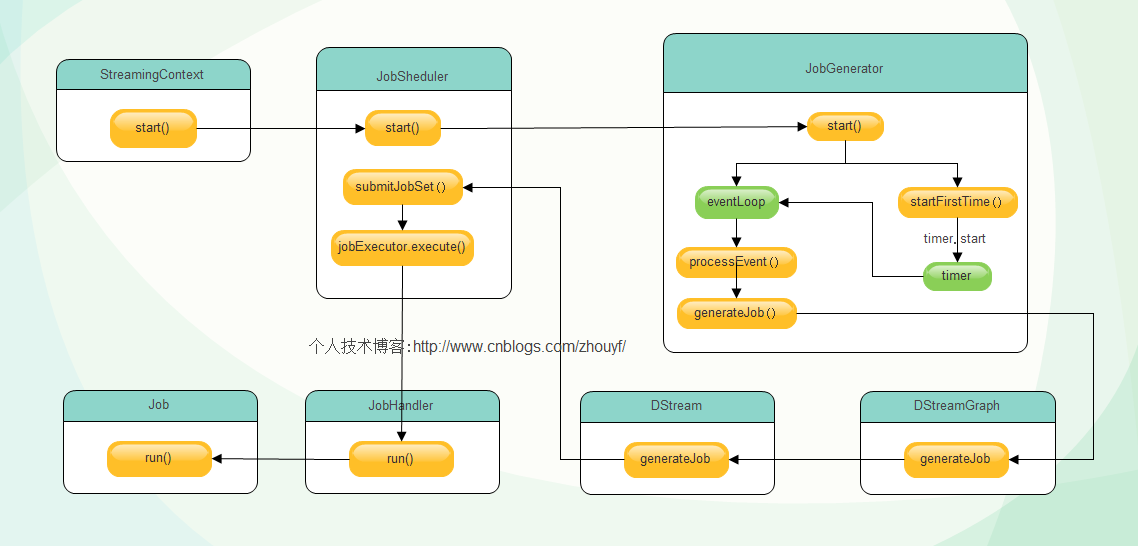Spark streaming 程序的运行过程是将DStream的操作转化成RDD的操作,Spark Streaming 和 Spark Core 的关系如下图(图片来自spark官网)

Spark Streaming 会按照程序设定的时间间隔不断动态生成Job来处理输入数据,这里的Job生成是指将Spark Streaming 的程序翻译成Spark内核的RDD操作,翻译的过程并不会触发Job的运行,Spark Streaming 会将翻译的处理逻辑封装在Job对象中,最后会将Job提交到集群上运行。这就是Spark Streaming 运行的基本过程。下面详细介绍Job动态生成和提交过程。


首先,当SparkStreaming的start方法调用后,整个Spark Streaming 程序开始运行,按照指定的时间间隔生成Job并提交给集群运行,在生成Job的工程中主要核心对象有
1.JobScheduler
2.JobGenerator
3.DStreamGraph
4.DStream
其中, JobScheduler 负责启动JobGenerator生成Job,并提交生成的Job到集群运行,这里的Job不是在spark core 中提到的job,它只是作业运行的代码模板,是逻辑级别的,可以类比java线程中的Runnable接口实现,不是真正运行的作业, 它封装了由DStream转化而来的RDD操作.JobGenerator负责定时调用DStreamingGraph的generateJob方法生成Job和清理Dstream的元数据, DStreamGraph持有构成DStream图的所有DStream对象,并调用DStream的generateJob方法生成具体Job对象.DStream生成最终的Job交给JobScheduler 调度执行。整体过程如下图所示:

下面结合源码分析每一步过程 (源码中黄色背景部分为核心逻辑代码,例如 : scheduler.start() ) :
首先,StreamingContext起动时调用start方法
try {validate()// Start the streaming scheduler in a new thread, so that thread local properties// like call sites and job groups can be reset without affecting those of the// current thread.ThreadUtils.runInNewThread("streaming-start") {sparkContext.setCallSite(startSite.get)sparkContext.clearJobGroup()sparkContext.setLocalProperty(SparkContext.SPARK_JOB_INTERRUPT_ON_CANCEL, "false")savedProperties.set(SerializationUtils.clone(sparkContext.localProperties.get()).asInstanceOf[Properties])scheduler.start()}state = StreamingContextState.ACTIVE} catch {case NonFatal(e) =>logError("Error starting the context, marking it as stopped", e)scheduler.stop(false)state = StreamingContextState.STOPPEDthrow e}
其中调用了scheduler的start方法,此处的scheduler 就是 org.apache.spark.streaming.scheduler.JobScheduler 对象,
StreamingContext持有org.apache.spark.streaming.scheduler.JobScheduler对象的引用。
下面看一下JobScheduler的start方法:
eventLoop = new EventLoop[JobSchedulerEvent]("JobScheduler") {override protected def onReceive(event: JobSchedulerEvent): Unit = processEvent(event)override protected def onError(e: Throwable): Unit = reportError("Error in job scheduler", e)}eventLoop.start()// attach rate controllers of input streams to receive batch completion updatesfor {inputDStream <- ssc.graph.getInputStreamsrateController <- inputDStream.rateController} ssc.addStreamingListener(rateController)listenerBus.start()receiverTracker = new ReceiverTracker(ssc)inputInfoTracker = new InputInfoTracker(ssc)executorAllocationManager = ExecutorAllocationManager.createIfEnabled(ssc.sparkContext,receiverTracker,ssc.conf,ssc.graph.batchDuration.milliseconds,clock)executorAllocationManager.foreach(ssc.addStreamingListener)receiverTracker.start()jobGenerator.start()executorAllocationManager.foreach(_.start())logInfo("Started JobScheduler")
可以看到JobScheduler调用了jobGenerator的start方法和eventLoop的start方法,eventLoop用来接收JobSchedulerEvent消息,并交给processEvent函数进行处理
代码如下:
private def processEvent(event: JobSchedulerEvent) {try {event match {case JobStarted(job, startTime) => handleJobStart(job, startTime)case JobCompleted(job, completedTime) => handleJobCompletion(job, completedTime)case ErrorReported(m, e) => handleError(m, e)}} catch {case e: Throwable =>reportError("Error in job scheduler", e)}}
可以看到JobScheduler中的eventLoop只处理JobStarted,JobCompleted和ErrorReported 三类消息,这三类消息的处理不是Job动态生成的核心逻辑代码先略过,(注意:后面JobGenerator中也有个eventLoop不要和这里的eventLoop混淆。)
JobGenerator的start方法首先new了一个EventLoop对象eventLoop,并复写onReceive(),将收到的JobGeneratorEvent 消息交给 processEvent 方法处理.源码如下:
/** Start generation of jobs */ def start(): Unit = synchronized { if (eventLoop != null) return // generator has already been started // Call checkpointWriter here to initialize it before eventLoop uses it to avoid a deadlock. // See SPARK-10125 checkpointWriter eventLoop = new EventLoop[JobGeneratorEvent]("JobGenerator") { override protected def onReceive(event: JobGeneratorEvent): Unit = processEvent(event) override protected def onError(e: Throwable): Unit = { jobScheduler.reportError("Error in job generator", e) } } eventLoop.start() if (ssc.isCheckpointPresent) { restart() } else { startFirstTime() } }
JobGenerator创建了eventLoop对象之后调用该对象的start方法,启动监听进程,准备接收JobGeneratorEvent类型消息交给processEvent函数处理,然后调用了startFirstTime方法,该方法启动DStreamGraph和定时器,定时器启动后根据程序设定的时间间隔给eventLoop对象发送GenerateJobs消息,如下图:

eventLoop对象收到 GenerateJobs 消息交个processEvent方法处理,processEvent收到该消息,调用generateJobs方法处理,源码如下:
/** Generate jobs and perform checkpoint for the given `time`. */private def generateJobs(time: Time) {// Checkpoint all RDDs marked for checkpointing to ensure their lineages are// truncated periodically. Otherwise, we may run into stack overflows (SPARK-6847).ssc.sparkContext.setLocalProperty(RDD.CHECKPOINT_ALL_MARKED_ANCESTORS, "true")Try {jobScheduler.receiverTracker.allocateBlocksToBatch(time) // allocate received blocks to batchgraph.generateJobs(time) // generate jobs using allocated block} match {case Success(jobs) =>val streamIdToInputInfos = jobScheduler.inputInfoTracker.getInfo(time)jobScheduler.submitJobSet(JobSet(time, jobs, streamIdToInputInfos))case Failure(e) =>jobScheduler.reportError("Error generating jobs for time " + time, e)}eventLoop.post(DoCheckpoint(time, clearCheckpointDataLater = false))}
JobGenerator中的generateJobs方法主要关注两行代码,首先调用graph的generateJobs方法,给方法返回Success(jobs) 或者 Failure(e),其中的jobs就是该方法返回的Job对象集合,如果Job创建成功,再调用JobScheduler的submitJobSet方法将job提交给集群执行。
首先分析Job对象的产生,DStreamGraph 的start方法源码:
def generateJobs(time: Time): Seq[Job] = {logDebug("Generating jobs for time " + time)val jobs = this.synchronized {outputStreams.flatMap { outputStream =>val jobOption = outputStream.generateJob(time)jobOption.foreach(_.setCallSite(outputStream.creationSite))jobOption}}logDebug("Generated " + jobs.length + " jobs for time " + time)jobs}
DStreamGraph 的start方法源码调用了outputStream对象的generateJob方法,ForeachDStream重写了该方法:
ForeachDStream的generateJob 将用户编写的DStream处理函数封装在jobFunc中,并将其传入Job对象,至此Job的生成。
接下来分析Job提交过程,JobScheduler负责Job的提交,核心代码在submitJobSet方法中:
def submitJobSet(jobSet: JobSet) {if (jobSet.jobs.isEmpty) {logInfo("No jobs added for time " + jobSet.time)} else {listenerBus.post(StreamingListenerBatchSubmitted(jobSet.toBatchInfo))jobSets.put(jobSet.time, jobSet)jobSet.jobs.foreach(job => jobExecutor.execute(new JobHandler(job)))logInfo("Added jobs for time " + jobSet.time)}}
其中jobExecutor对象是一个线程池,JobHandler实现了Runnable接口,在JobHandler 的run方法中会调用传入的job对象的run方法。
疑问:Job的run方法执行是如何触发RDD的Action操作从而出发job的真正运行的呢?我们下次再具体分析,请随时关注博客更新!